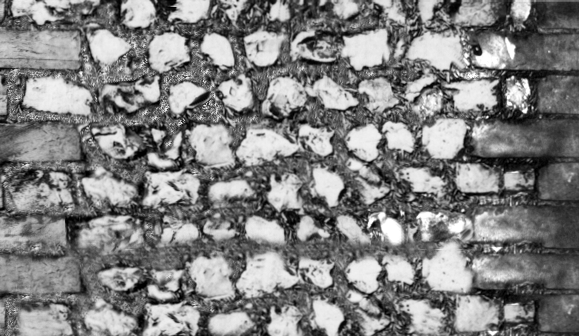Flint and bungaroush
Flints are irregular hard, brittle, glass-like rocks, now generally thought to be the remnant of giant sponge colonies. Flints are generally nodular/irregular in shape and vary in size considerably. Those that have been subject to water erosion are far more rounded and, of course, are smaller. As a building material flint is attractive due to its portability, durability, widespread availability and relatively low cost.
Since flint was both plentiful and cheap in the Sussex area, it became a very popular building material in Regency Brighton and was used in a number of ways.
Flints are usually laid with mortar, in a manner similar to that used when building with bricks. The way in which flints are arranged in walling is called ‘bonding’; rather like a series of teeth, each flint has a root tailing into the wall.
Walls can be built with either irregularly shaped field flints and smooth beach or ‘cobble’ flints. However, the latter require more mortar for jointing than irregular stones. It also needs to be a higher quality mortar, resistant to erosion and crumbling. The simple flint wall widely seen in the Brighton area is built using cobble flints and brought to a fair face finish with mortar.

Above: Flint wall in Brighton.
Alternatively, walls can be built using ‘snapped’ or ‘knapped’ flints. A snapped flint wall is built of stones that have been broken in half to exposed an inner face, usually of a circular or oval shape. In knapped flint construction, the snapped flint is further processed to square off the round edges so that cube shaped flints can be laid in precise horizontal rows. Sometimes flints are knapped with such precision that walls can be built without the need for regular brick quoins or string courses, which would normally be required to overcome any irregularities within the flint blocks.
Another form of flint walling that makes use of unprocessed, or little processed stones is known locally as bungaroush. This is used when a sophisticated masonry finish is not required.
Bungaroush
There seems to be no precise definition, or spelling, for bungaroush, but in principle the term describes a cheap form of shutter erected walling based upon the following ingredients: flint, brick-snaps (the broken and otherwise unusable brick pieces left over form the clamp firing process), small shingle or ‘pea beach’, and lime mortar.
These walls begin with a foundation course of brickwork and a series of brick quoins. Timber shuttering was then erected to contain a slurry of flint, brick-snap, lime mortar and shingle poured between the timber in much the same way as poured concrete is formed today. Sometimes a timber framework was used instead of the more usual brickwork.
Bungaroush walls are normally rendered with an external stucco or an internal plaster. In situations where the bungaroush is to form an external wall without the benefit of a render layer, the rapid erosion of the wall by water could be prevented by the adoption of a ‘galetted’ finish. This is where small flint chips were pushed into the wall, sometimes in a downward sloping direction, to shed water. Although designed as a cheap, fast walling system, high quality grey lime mortar and a good quality render or, where appropriate, galetting, has ensured considerable stability and longevity. Good examples bungaroush walling can often be found in roof spaces and basement cellar walls.
Most of the masonary walling in Brighton’s Regency homes that is not in brick is made of bungaroush.
If you are interested in further reading on this topic, these links will provide you with more information:
Discovering Flint; Information about flint, it's uses and fossils
'Flint and the Conservation of Flint Buildings' by John Ashurts and Gerry Williams
Regency Society; Living with bungaroush
Finally, a rather negative article about bungaroush, much of which we would not support as accurate:


